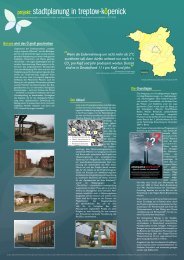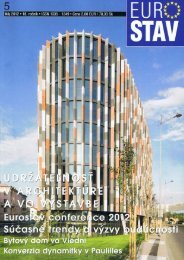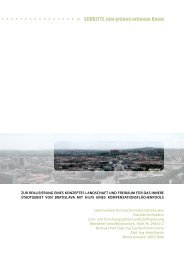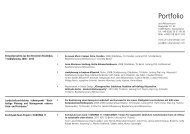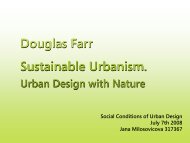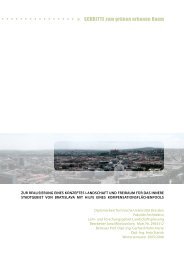Thesis document - Jana Milosovicova - Urban Design English
Thesis document - Jana Milosovicova - Urban Design English
Thesis document - Jana Milosovicova - Urban Design English
- No tags were found...
You also want an ePaper? Increase the reach of your titles
YUMPU automatically turns print PDFs into web optimized ePapers that Google loves.
wave radiation towards the sky. In a medium-density area (H/W ratioof about 1), much of the reflected radiation strikes other buildings orthe ground and is eventually absorbed at and near the ground level. Ina high-density area (with an H/W ratio of about 4 and more), most ofthe absorption takes place high above the ground level. Consequently,the amount of radiation reaching the ground, and heating the air nearthe ground, is smaller than in case of medium or low density. Thiswould imply that the higher H/W ratio, the lower heating of the urbanenvironment.A higher H/W ratio, however, partially restricts the emitting of thestored heat into the atmosphere at night – and thus slows down thenight cooling of the urban environment. Emmanuel (2005) and Matzarakis(2001), for example, are due to this fact convinced that a highH/W ratio significantly contributes to the UHI intensity. For this reason,Emmanuel (2005) and Oke (1988) advocate a H/W ratio of 0.4-0.6in order to trap minimal heat in summer and enhance the trapping inwinter (Emmanuel 2005, p. 39), also satisfying other goals, such aspollution dispersal, solar access, shelter and heat island extent. Emmanuelclaims that although typical central areas in European cities donot conform to the above values (H/W in Europe = 0.75–1.7), comparingthese with the cores of North American cities (where the H/W =1.15–3.3), the compact European cities are still closer to these figuresand thus “more likely to conform to the suggested compatible rangesthan the North American dense cores and scattered suburbs” (Oke,1988 in Raydan and Steemers 2006, p. 22-23).However, a study by Herrmann and Matzarakis (2010, p. 524-525) foran idealized street canyon in Freiburg, a cool moderate-climate city,showed that the most suitable H/W ratio for low temperatures inthe street canyon, given that the street has an East-West orientation,is higher than the values suggested by Emmanuel and Oke – the H/Whas a value of 1.0 and higher. (In case of South-North orientation,the temperatures were generally higher at any H/W ratio.) Despite thetwo deficits of this study: (a) the modellings were made for the periodoutside the summer when the heat wave occurrence is highest and (b)the study did not consider other factors, such as the presence of urbanvegetation and the anthropogenic heat production; this study gives theclearest answers on the appropriate H/W ratio of urban canyons in thecool moderate climate zone.Still, there is a clear controversity of the H/W parameter – on the onehand, the lower the H/W ratio, the higher the insolation and thus streetcanyon heating; on the other hand, the higher the H/W ratio, the lowerthe cooling ability of a street canyon at night. Therefore, an exactstudy should be made for every particular planning situation,and involve the overall density of the area, street orientation,vehicular traffic intensity, buildings’ energy performance andheat exhausts, surface design and greening measures.Fig. 25 The ‘sky view factor’ is equal 1 in caseof unobstructed horizontal area; if a point issurrounded by buildings, it is lower than 1.(Dirk Wolters / KNMI)It can be, for example, assumed, that if the buildings’ surface was coveredwith vegetation, the proportion of the thermal energy consumedby evapotranspiration would be much higher, the impinging solar radiationstored in the construction material and thus the temperature in-24Climate Sensitive <strong>Urban</strong> <strong>Design</strong> in Moderate Climate Zone: Responding to Future Heat Waves. Case Study Berlin Heidestrasse/Europacity



